DMM Aneng AN860B+

This is a cheap DMM with all common function.
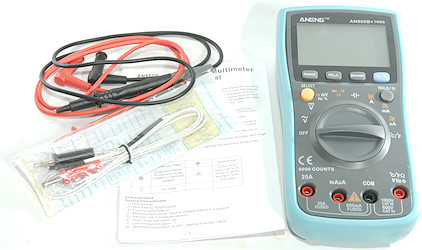
It included the DMM, a pair of probes and a manual (Where some specifications was missing).
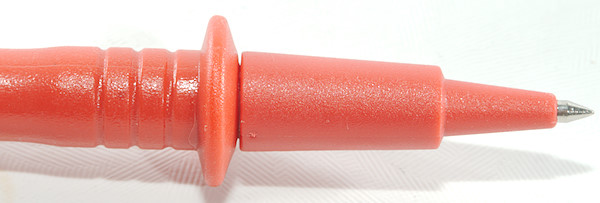

The probes has removable tip covers.

The probes are rated for 10A, I would not trust that but use some more solid wire for 20A range.


The thermocoupler is a cheap construction rated for max. 400° 0.75% ±2.5°±C
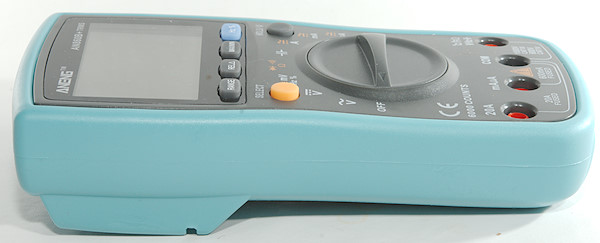
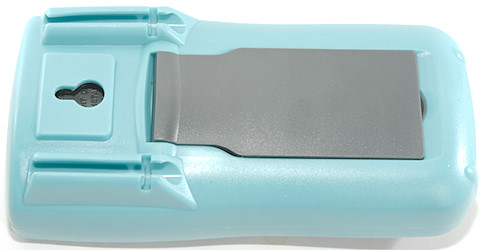
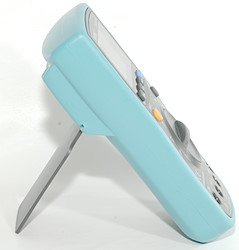
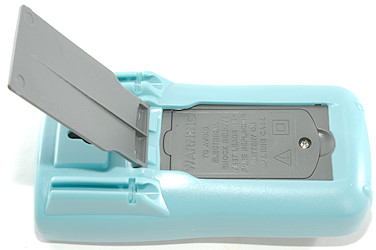
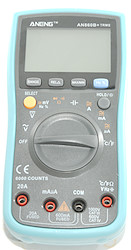
When using the tilting bale the meter is nearly stable enough to turn the switch and push the buttons (If placed on a non-slip surface it will probably be stable enough).
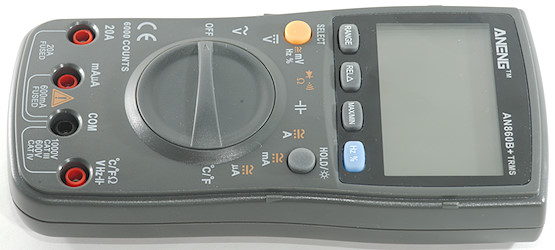
Meter without rubber sleeve, battery can be replaced without removing this sleeve.
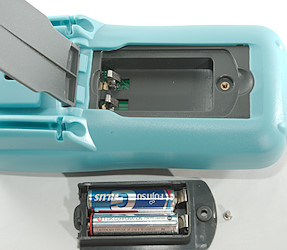
Display
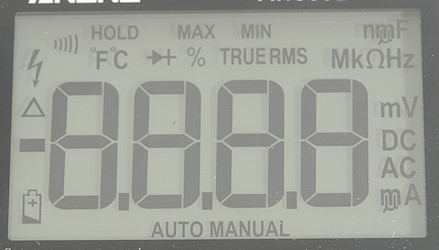
The above picture shows all the segments on the display.
Notice how u and m symbols are at multiple locations, making it possible to show them just before the unit.
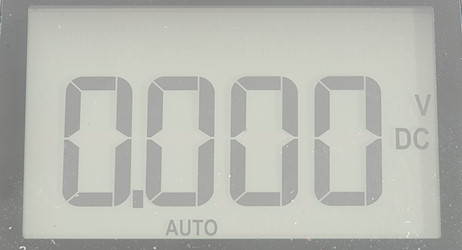
Typical display during usage, it will show the number and what measurement is selected.
Functions
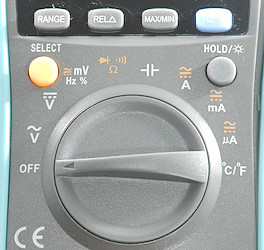
Buttons:
- Range: Will disable auto range and change range, hold down to activate auto range.
- Rel: Shows values relative to current value, will also select manual range. Press again to disable.
- Max/min: Starts recording maximum and minimum value, press to select between max/min.
- Hz % (Blue): Shows frequency and duty cycle in AC ranges.
- Select (Yellow): Select the ranges printed with yellow and between C°/F°
- Hold: Freezes the display, hold down for backlight.
Rotary switch:
- Off: Meter is turned off
- VAC: Show AC voltage, using the blue button frequency and duty cycle can be selected.
- VDC: Show DC voltage.
- mV: Show DC or AC mV. In AC the blue button will show frequency and duty cycle.
- ohm: Resistance, continuity, diode
- Capacitance: Capacitor.
- A: Current AC and DC. In AC the blue button will show frequency and duty cycle.
- mA: Current AC and DC. In AC the blue button will show frequency and duty cycle. Watch out for burden voltage.
- uA: Current AC and DC. In AC the blue button will show frequency and duty cycle.
- °C/°F: Temperature.
Input
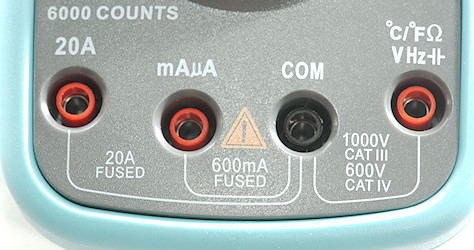
- 20A: High current, it can only withstand 10+ ampere for a short time (Fuse is 10A).
- mAuA: The lower current ranges, the selector switch will change between two different shunts (Fuse is 600mA).
- CON: The common terminal for all ranges.
- xxx: All other ranges.
The terminals are a bit loose in the mounting due to the way they are made. My Keysight probes are very loose and cannot be fully pushed down (Standard banana plugs will fit). Opening up the meter and giving the terminals a squeeze may fix it.
Measurements
- Volt and frequency
- At 10mVrms input frequency range is from 1Hz to 600kHz
- At 1Vrms input frequency range can be stretched to 8MHz
- Max/min needs about 340ms to capture a voltage.
- 1 VAC is 5% down at 2.1kHz (RMS will not work at the frequency).
- Frequency counter and duty cycle can only be selected in AC ranges.
- Frequency input requires a zero crossing.
- Duty cycle works from 2% to above 99% at 100kHz with 1Vpp, precision is within 0.2 (Mostly 0.1).
- Input impedance is 11.5Mohm on DC and AC
- mV range is high impedance for DC up to around 2 volt and 10Mohm for AC
- Frequency input is 10Mohm up to around 2 volt, then the protection clamps to 2kOhm
- Current
- On the 6000uA & 600mA range there is an audible alarm when going above range.
- 20A range will give audible alarm at 10A after some time and immediately at 20A.
- Frequency counter and duty cycle can only be selected in AC ranges.
- Current is protected by a 0.5A/250V fuse and 20A/250V fuse.
- Ohm, Continuity, diode and capacitance
- Ohm needs about 2.6s to measure 100ohm
- Ohm is 1.0V open and 0.39mA shorted
- Continuity is fast (About 20ms).
- Continuity beeps when resistance is below 50ohm.
- Continuity is 1.0V open and 0.39mA shorted
- Diode range uses 3.2V, max. display is 3.0V at 0.1mA, max. current is 1.7mA shorted
- 70000uF takes about 8 seconds to measure.
- Overload protection is rated for 550V AC/DC
- Miscellaneous
- There is no temperature compensation near the connector
- Current consumption of meter is 1.6mA (7.5mA with backlight)
- Meter works down to 2.2V where it turns off, battery symbol show at 2.4V.
- Reading will change slightly with battery voltage: 5 count on a 5V reading from 3V to 2.4V.
- Backlight only works down to about 2.6V where it is fairly dim.
- The meter usual need a couple of display update to reach the final value.
- Viewing angle is good, except from the top.
- Display updates around 3 times/sec
- Backlight will automatic turn off in about 15 seconds.
- Will automatic turn power off in about 15 minutes.
- Standard probes cannot be pushed fully down are very loose.
- Weight is 366g without accessories, but with rubber sleeve and batteries.
- Size is 180 x 89 x 44mm with rubber sleeve.
- Probes
- Probe resistance 59mOhm for one.
- Probe wire is soft and 65cm long.

A look at the capacitance measurement waveform.

Frequency input resistance depends on input voltage.

Tear down
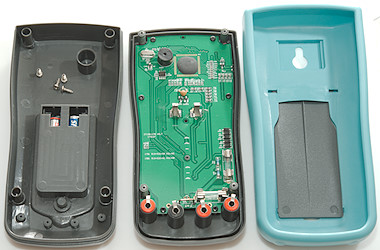
Four screws and the back could be removed.
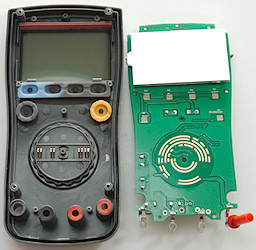
6 more screws for the front.
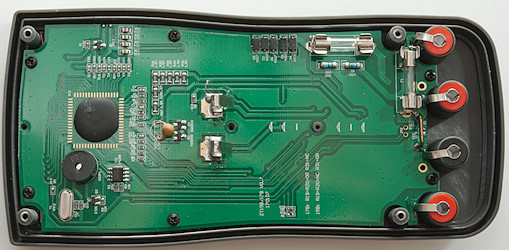
There is not much inside this meter. The main chip (IC2) is under the black blob, the calibration and function memory is a EEPROM (IC1:24C01). The buzzer (BZZP1) needs a transistor (Q2), same with the backlight (Q1).
There is a long voltage divider chain (R26, R27, R28, R29, R30, R35, R36) of 7 1.5Mohm resistors, this goes directly into the main chip. There is also the test current output (Used in ohm and capacitance), this has a PTC (PTC1) and two transistors as clamp (Q3, Q4).
There is a 600mA glass fuse (F2) and two resistors for the uA (R23: 99ohm) and mA (R24: 1ohm) range and 5 diodes (D2, D3, D4, D5, D6) as protection. The 20A ranges has a 10A fuse (F1) and a wire resistor.
Notice the solder blop between tracks just above the battery terminal.


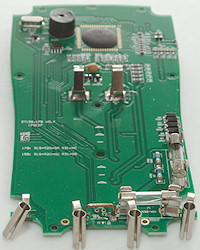

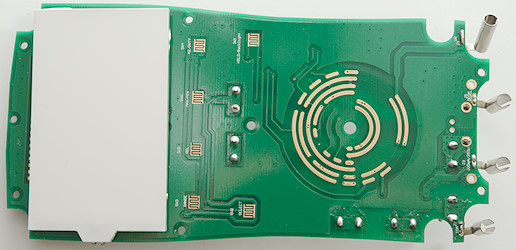
This side of the circuit board only has the switches and the backlight. The display is connected with a zebra stip.
Conclusion
The meter is easily within the specified tolerances and it has lot of functions and ranges, but the CAT rating is fake.
Glass fuses cannot break high currents at high voltage, it requires ceramic fuses with sand inside. The protection on the ohm/capacitance range do not look very robust, i.e. the meter may not survive high voltage on these ranges.
The 6000 count gives a good resolution at 4V and 5V, this can be useful.
Watch out for burden voltage in the 6mA and 600mA range, it can be significant.
I will call it acceptable DMM for hobby use (I am not happy about the bad fit of my other probes), but keep it away from anything with mains voltage and lots of amps.
Notes
This meter exist with many different names on it and small variations in functions.
How do I review a DMM
More DMM reviews




























